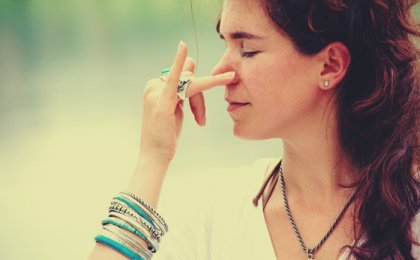Breathing is an activity that we do by default, involuntarily. Did you know that if we do it in a conscious, focused and harmonious way we will obtain many benefits? Learn the most effective techniques to achieve this and take advantage of all the good things that this act brings.
Breathing techniques force us to remember that this metabolic act is much more than a physical process. Because breathing well produces pleasure, relieves anxiety, and allows us to live better. So, something that would undoubtedly be very useful to us is to make this act a much more conscious, focused, and harmonious exercise in our daily lives.
Most people have never stopped to analyze the way they breathe. The question is, why do we do it? Our body is that almost perfect machine that performs a good number of processes automatically, thereby ensuring our survival. Thanks to this, we can dedicate a good part of our energy to other tasks, such as reading this article, for example.
“When I breathe in, I see myself as still water. When I breathe out, I reflect on things as they are.”
-Thich Nhat Hanh-
Now, questioning this simple scheme can do us good. Neglecting the body has consequences and allowing our emotions to take over also leads to worse results. Let us not forget that an exhausted, stiff, or overly worried organism, controlled by excessive worry, rushing, or anxiety, results in faster and abnormal breathing, in a body that performs its metabolic tasks at an unbalanced and even dangerous pace.
We need to breathe better to live optimally and these techniques can help us.
1. Breathing techniques: the respiratory diaphragm
Most of us, when we think about breathing, instantly visualize a pair of lungs. Well, it’s fair to say that the real person responsible for this process is the diaphragm. It’s right there, under the lungs and separating the chest from the abdominal area. It moves when we breathe, and if we do so with ample force, it will stimulate other organs such as the liver and a large number of tissues to promote blood circulation, even promoting the elimination of toxins.
This area of our body needs to be taken into account much more because the diaphragm is the essential part of most breathing techniques. Let’s see, therefore, how to become aware of it and how to stimulate it.
- We place one hand on the abdomen and the other on the chest.
- The back should be straight.
- Now we take a deep breath through our noses.
- We must make sure that the area that swells is the diaphragm (the abdomen), not the chest.
- Then we exhale through the mouth in a loud manner.
- The idea is to take between 6 and 10 slow breaths per minute.
2. Alternate nostril breathing
This is one of the most well-known breathing techniques. It is also ideal for reducing anxiety, relaxing, and promoting better concentration in everyday life. These are the steps we should follow:
- We will sit comfortably, always remembering to keep our backs straight.
- Now, with the right thumb, we will cover the right nostril.
- Next, we will inhale oxygen deeply through the left nostril until we reach our limit.
- We hold our breath and then cover the left nostril and exhale through the right.
- We repeat the process in reverse.
It may seem complicated at first, but as soon as we automate the steps we will see its incredible benefits.
3. Bright Skull Breath or Kapalabhati
Kapalabhati is one of the most interesting and effective breathing techniques for reducing anxiety and optimizing our respiratory system. It helps us cleanse the airways and even improves lung capacity.
The term kapalabhati comes from Sanskrit and is made up of two concepts: kapala meaning “skull” and bhati meaning “shine or the act of cleaning”. Let’s see what it consists of:
- We sat back down with our backs straight.
- We bring the chin towards the chest.
- We will close our eyes to better concentrate on our breathing.
- We inhale deeply.
- Now we will do the following: we will proceed to perform rapid exhalations contracting the abdominal muscles, imagining that with this act we bring the navel towards the spine.
- As you do these exhalations, your body will automatically inhale again. Ideally, you should do at least 10 to 15 quick exhalations in a row. Rest for a few minutes and start again.
4. Breathing technique with visualization
Many breathing techniques include various visualizations to achieve deeper relaxation. However, it requires a little more skill so that the whole process benefits us and embraces us with those cathartic sensations capable of extinguishing tensions and dispelling anxiety or stress.
Let us therefore take note of this very original strategy.
- We will lie down on the floor on a mat or even on the bed.
- We will place one hand on the abdomen and another on the chest to control that we are breathing through the diaphragm.
- Now we will inhale deeply through the nose and imagine that a wave of the sea is covering us warmly from the feet to the head. We will feel its freshness, the bubbling of the water, the drag of the sea covering us…
- Now we will exhale through the mouth and visualize at the same time the same wave slowly receding from us from head to toe, in a slow, relaxing way…
To conclude, as we can see, these simple breathing techniques can help us improve our well-being, take care of our health, and untie the knot of all those tensions that, almost without us realizing it, are slowly making us sick. Let us find a few minutes throughout the day to breathe better, to live in greater harmony with our own body and its needs.
